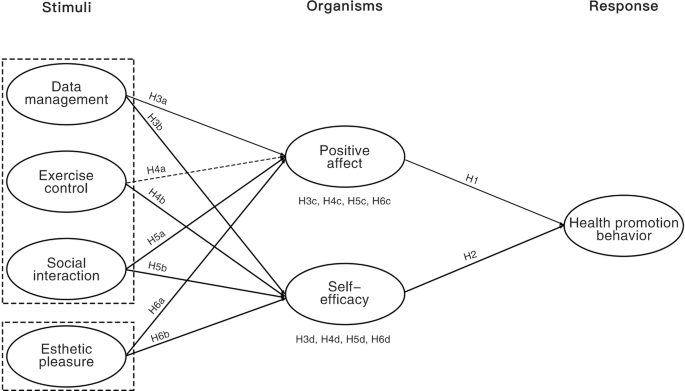
Abernethy A, Adams L, Barrett M et al. (2022) The promise of digital health: then, now, and the future. NAM Perspect 6:108–116. https://doi.org/10.31478/202206e
Google Scholar
AI-Emran M, Al-Maroof R, Al-Sharafi MA et al. (2022) What impacts learning with wearables? An integrated theoretical model. Interact Learn Environ 30(10):1897–1917. https://doi.org/10.1080/10494820.2020.1753216
Google Scholar
Amaya Rivas A, Liao YK, Vu MQ et al. (2022) Toward a comprehensive model of green marketing and innovative green adoption: application of a stimulus-organism-response model. Sustainability 14(6):3288. https://doi.org/10.3390/su14063288
Google Scholar
Andersen TO, Langstrup H, Lomborg S (2020) Experiences with wearable activity data during self-care by chronic heart patients: qualitative study. J Med Internet Res 22(7):e15873. https://doi.org/10.2196/15873
Google Scholar
Araujo T (2018) Living up to the chatbot hype: the influence of anthropomorphic design cues and communicative agency framing on conversational agent and company perceptions. Comput Hum Behav 85(85):183–189. https://doi.org/10.1016/j.chb.2018.03.051
Google Scholar
Asimakopoulos S, Asimakopoulos G, Spillers F (2017) Motivation and user engagement in fitness tracking: heuristics for mobile healthcare wearables. Informatics 4(1):5. https://doi.org/10.3390/informatics4010005
Google Scholar
Azizan A, Justine M, Kuan CS (2013) Effects of a behavioral program on exercise adherence and exercise self-efficacy in community-dwelling older persons. Curr Gerontol Geriatr Res 2013(1):282315. https://doi.org/10.1155/2013/282315
Google Scholar
Bagozzi RP, Yi Y, Phillips LW (1991) Assessing construct validity in organizational research. Admin Sci Quart 36(3):421–458. https://doi.org/10.2307/2393203
Google Scholar
Bandura A (1997) Self-efficacy: the exercise of control. W.H. Freeman and Company, New York. https://doi.org/10.5860/choice.35-1826
Bandura A (2014) Self-efficacy mechanism in psychobiologic functioning. In: Schwarzer R (ed) Self-efficacy: thought control of action, 1st edn. Taylor & Francis, New York, pp 355–394
Becker H, Stuifbergen A, Oh HS et al. (1993) Self-rated abilities for health practices: a health self-efficacy measure. Health Val J Health Behav Educ Promot 17(5):42–50
Beg S, Handa M, Shukla R et al. (2022) Wearable smart devices in cancer diagnosis and remote clinical trial monitoring: transforming the healthcare applications. Drug Discov Today 27(10):103314. https://doi.org/10.1016/j.drudis.2022.06.014
Google Scholar
Berriche M, Altay S (2020) Internet users engage more with phatic posts than with health misinformation on Facebook. Palgrave Commun 6(1):1–9. https://doi.org/10.1057/s41599-020-0452-1
Google Scholar
Blijlevens J, Thurgood C, Hekkert P et al. (2017) The aesthetic pleasure in design scale: the development of a scale to measure aesthetic pleasure for designed artifacts. Psychol Aesthet Creat 11(1):86–98. https://doi.org/10.1037/aca0000098
Google Scholar
Boldi A, Silacci A, Boldi MO et al. (2024) Exploring the impact of commercial wearable activity trackers on body awareness and body representations: a mixed-methods study on self-tracking. Comput Hum Behav 151:108036. https://doi.org/10.1016/j.chb.2023.108036
Google Scholar
Bölen MC (2020) Exploring the determinants of users’ continuance intention in smartwatches. Technol Soc 60(1):101209. https://doi.org/10.1016/j.techsoc.2019.101209
Google Scholar
Burr C, Cristianini N, Ladyman J (2018) An analysis of the interaction between intelligent software agents and human users. Mind Mach 28(4):735–774. https://doi.org/10.1007/s11023-018-9479-0
Google Scholar
Byrne BM, Baron P, Balev J (1998) The beck depression inventory: a cross-validated test of second-order factorial structure for Bulgarian adolescents. Educ Psychol Meas 58(2):241–251. https://doi.org/10.1177/0013164498058002007
Google Scholar
Canhoto AI, Arp S (2017) Exploring the factors that support the adoption and sustained use of health and fitness wearables. J Market Manag 33(1–2):32–60. https://doi.org/10.1080/0267257x.2016.1234505
Castiello U, Becchio C, Zoia S et al. (2010) Wired to be social: the ontogeny of human interaction. PLoS ONE 5(10):e13199. https://doi.org/10.1371/journal.pone.0013199
Google Scholar
Chandrasekaran R, Katthula V, Moustakas E (2020) Patterns of use and key predictors for the use of wearable health care devices by US adults: insights from a national survey. J Med Internet Res 22(10):e22443. https://doi.org/10.2196/22443
Google Scholar
Cheng JW, Mitomo H (2017) The underlying factors of the perceived usefulness of using smart wearable devices for disaster applications. Telemat Inf 34(2):528–539. https://doi.org/10.1016/j.tele.2016.09.010
Google Scholar
Chiang JH, Yang PC, Tu H (2014) Pattern analysis in daily physical activity data for personal health management. Pervasive Mob Comput 13:13–25. https://doi.org/10.1016/j.pmcj.2013.12.003
Google Scholar
Chib A, Lin SH (2018) Theoretical advancements in mHealth: a systematic review of mobile apps. J Health Commun 23(10–11):909–955. https://doi.org/10.1080/10810730.2018.1544676
Google Scholar
Chiou WB, Wan CS (2007) The dynamic change of self-efficacy in information searching on the internet: influence of valence of experience and prior self-efficacy. J Psychol 141(6):589–603. https://doi.org/10.3200/jrlp.141.6.589-604
Google Scholar
Chitturi R, Raghunathan R, Mahajan V (2008) Delight by design: the role of hedonic versus utilitarian benefits. J Mark 72(3):48–63. https://doi.org/10.1509/JMKG.72.3.048
Google Scholar
Cho WC, Lee KY, Yang SB (2019) What makes you feel attached to smartwatches? The stimulus-organism-response (S-O-R) perspectives. Inf Technol People 32(2):319–343. https://doi.org/10.1108/itp-05-2017-0152
Google Scholar
Choe EK, Lee B, Munson S et al. (2013) Persuasive performance feedback: the effect of framing on self-efficacy. AMIA Annu Symp Proc 2013:825–833
Google Scholar
Cohen S, Pressman SD (2006) Positive affect and health. Curr Dir Psychol Sci 15(3):122–125. https://doi.org/10.1111/j.0963-7214.2006.00420.x
Google Scholar
Colombetti G (2003) Complexity as a new framework for emotion theories. Log Philos Sci 1(1):1–16
Dehghani M, Kim KJ, Dangelico RM (2018) Will smartwatches last? Factors contributing to intention to keep using smart wearable technology. Telemat Inf 35(2):480–490. https://doi.org/10.1016/j.tele.2018.01.007
Google Scholar
Diener E, Chan MY (2011) Happy people live longer: subjective well-being contributes to health and longevity. Appl Psychol Health WellBeing 3(1):1–43. https://doi.org/10.1111/j.1758-0854.2010.01045.x
Google Scholar
Dimou E, Manavis A, Papachristou E et al. (2017) A conceptual design of intelligent shoes for pregnant women. In: Rinaldi R, Bandinelli R (eds) Business models and ICT technologies for the fashion supply chain. IT4Fashion 2016. Lecture notes in electrical engineering, vol 413. Springer, Cham, pp 69–77. https://doi.org/10.1007/978-3-319-48511-9_6
Dunn J, Runge R, Snyder M (2018) Wearables and the medical revolution. Pers Med 15(5):429–448. https://doi.org/10.2217/pme-2018-0044
Google Scholar
Ebstrup JF, Eplov LF, Pisinger C (2011) Association between the five factor personality traits and perceived stress: is the effect mediated by general self-efficacy? Anxiety Stress Copin 24(4):407–419. https://doi.org/10.1080/10615806.2010.540012
Google Scholar
Fallon M, Spohrer K, Heinzl A (2019) Wearable devices: a physiological and self-regulatory intervention for increasing attention in the workplace. In: Davis F, Riedl R, Vom Brocke J, Léger PM, Randolph A (eds) Information systems and neuroscience. Lecture notes in information systems and organisation, vol 29. Springer, Cham, pp 229–238. https://doi.org/10.1007/978-3-030-01087-4_28
Fan C, Forlizzi J, Dey A (2012) Considerations for technology that support physical activity by older adults. Paper presented at the 14th international ACM SIGACCESS conference on Computers and accessibility, Carnegie Mellon University, Pittsburgh, 22–24 Oct 2012. https://doi.org/10.1145/2384916.2384923
Fogg BJ (2003) Persuasive technology: using computers to change what we think and do. Morgan Kaufmann, Amsterdam
Fang Y, Gao X, Sun C et al. (2024) The mediating role of health consciousness in the relation between time-related personality and health-promoting behavior. Curr Psychol 43(4):3649–3656. https://doi.org/10.1007/s12144-023-04617-x
Google Scholar
Fornell C, Larcker DF (1981) Evaluating structural equation models with unobservable variables and measurement error. J Mark Res 18(1):39–50. https://doi.org/10.2307/3151312
Google Scholar
Gibbons FX, Buunk BP (1999) Individual differences in social comparison: development of a scale of social comparison orientation. J Pers Soc Psychol 76(1):129. https://doi.org/10.1037/0022-3514.76.1.129
Google Scholar
Gowin M, Wilkerson A, Maness S et al. (2019) Wearable activity tracker use in young adults through the lens of social cognitive theory. Am J Health Educ 50(1):40–51. https://doi.org/10.1080/19325037.2018.1548314
Google Scholar
Grembowski D, Patrick D, Diehr P et al. (1993) Self-efficacy and health behavior among older adults. J Health Soc Behav 34(2):89. https://doi.org/10.2307/2137237
Google Scholar
Gualtieri L, Rosenbluth S, Phillips J (2016) Can a free wearable activity tracker change behavior? The impact of trackers on adults in a physician-led wellness group. JMIR Res Protoc 5(4):e237. https://doi.org/10.2196/resprot.6534
Google Scholar
Guntzviller LM, King AJ, Jensen JD et al. (2017) Self-efficacy, health literacy, and nutrition and exercise behaviors in a low-income, Hispanic population. J Immigr Minor Health 19(2):489–493. https://doi.org/10.1007/s10903-016-0384-4
Google Scholar
Gür F, Gür GC, Ayan V (2020) The effect of the ERVE smartphone app on physical activity, quality of life, self-efficacy, and exercise motivation for inactive people: a randomized controlled trial. Eur J Integr Med 39:101198. https://doi.org/10.1016/j.eujim.2020.101198
Google Scholar
Hair JF, Sarstedt M, Ringle CM et al. (2012) An assessment of the use of partial least squares structural equation modeling in marketing research. J Acad Mark Sci 40(3):414–433. https://doi.org/10.1007/s11747-011-0261-6
Google Scholar
Hassenzahl M, Wiklund-Engblom A, Bengs A et al. (2015) Experience-oriented and product-oriented evaluation: psychological need fulfillment, positive affect, and product perception. Int J Hum Comput Int 31(8):530–544. https://doi.org/10.1080/10447318.2015.1064664
Google Scholar
Hayes AF (2017) Introduction to mediation, moderation, and conditional process analysis: a regression-based approach. Guilford Publications, New York
Hekkert P (2006) Design aesthetics: principles of pleasure in design. Psychol Sci 48(2):157
Henseler J, Ringle CM, Sarstedt M (2015) A new criterion for assessing discriminant validity in variance-based structural equation modeling. J Acad Mark Sci 43:115–135. https://doi.org/10.1007/s11747-014-0403-8
Google Scholar
Hosseinpour M, Terlutter R (2019) Your personal motivator is with you: a systematic review of mobile phone applications aiming at increasing physical activity. Sports Med 49(9):1425–1447. https://doi.org/10.1007/s40279-019-01128-3
Google Scholar
Hsiao KL, Chen CC (2018) What drives smartwatch purchase intention? Perspectives from hardware, software, design, and value. Telemat Inf 35(1):103–113. https://doi.org/10.1016/j.tele.2017.10.002
Google Scholar
Hu X, Huang Q, Zhong X et al. (2016) The influence of peer characteristics and technical features of a social shopping website on a consumer’s purchase intention. Int J Inf Manag 36(6):1218–1230. https://doi.org/10.1016/j.ijinfomgt.2016.08.005
Google Scholar
Huang D, Chen Q, Huang S et al. (2024) Consumer intention to use service robots: a cognitive-affective-conative framework. Int J Contemp Hosp Manag 36(6):1893–1913. https://doi.org/10.1108/IJCHM-12-2022-1528
Google Scholar
Ilioudi S, Lazakidou A, Tsironi M (2010) Information and communication technologies for better patient self-management and self-efficacy. Int J Electron Health 5(4):327. https://doi.org/10.1504/ijeh.2010.036205
Google Scholar
Intille SS (2004) A new research challenge: persuasive technology to motivate healthy aging. IEEE Trans Inf Technol Biomed 8(3):235–237. https://doi.org/10.1109/titb.2004.835531
Google Scholar
Iyawa GE, Herselman M, Botha A (2016) Digital health innovation ecosystems: from systematic literature review to conceptual framework. Procedia Comput Sci 100:244–252. https://doi.org/10.1016/j.procs.2016.09.149
Google Scholar
Jackson ES, Tucker CM, Herman KC (2007) Health value, perceived social support, and health self-efficacy as factors in a health-promoting lifestyle. J Am Coll Health 56(1):69–74. https://doi.org/10.3200/jach.56.1.69-74
Google Scholar
Jafarlou S, Lai J, Azimi I et al. (2023) Objective prediction of next-day’s affect using multimodal physiological and behavioral data: algorithm development and validation study. JMIR Form Res 7(1):e39425. https://doi.org/10.2196/39425
Google Scholar
James TL, Wallace L, Deane JK (2019) Using organismic integration theory to explore the associations between users’ exercise motivations and fitness technology feature set use. MIS Q 43(1):287–312. https://doi.org/10.25300/misq/2019/14128
Google Scholar
Jia G, Fan DX, Xu J et al. (2024) Tourist prosocial behavior: scale development and its role between tourist destination social exclusion and wellbeing. J Sustain Tour 32(12):2518–2539. https://doi.org/10.1080/09669582.2023.2289357
Google Scholar
Jia M, Cheng J (2024) Effect of teacher social support on students’ emotions and learning engagement: a U.S.-Chinese classroom investigation. Humanit Soc Sci Commun 11(1):1–9. https://doi.org/10.1057/s41599-024-02634-0
Google Scholar
Jocevski M, Arvidsson N, Ghezzi A (2020) Interconnected business models: present debates and future agenda. J Bus Ind Mark 35(6):1051–1067. https://doi.org/10.1108/jbim-06-2019-0292
Google Scholar
Jung Y, Choi B, Cho W (2021) Group satisfaction with group work under surveillance: the stimulus-organism-response (SOR) perspective. Telemat Inf 58(3):101530. https://doi.org/10.1016/j.tele.2020.101530
Google Scholar
Jung Y, Kim S, Choi B (2016) Consumer valuation of the wearables: the case of smartwatches. Comput Hum Behav 63:899–905. https://doi.org/10.1016/j.chb.2016.06.040
Google Scholar
Karahanoğlu A, Erbuğ Ç (2011) Perceived qualities of smart wearables: determinants of user acceptance. In: Proceedings of the 2011 Conference on Designing Pleasurable Products and Interfaces, Middle East Technical University, Ankara/Turkey, 22–25 June. https://doi.org/10.1145/2347504.2347533
Kashian N, Liu Y (2020) Posting exercise activity on social media for self-efficacy and well-being. South Commun J 85(2):1–12. https://doi.org/10.1080/1041794x.2019.1658801
Google Scholar
Kerner C, Goodyear VA (2017) The motivational impact of wearable healthy lifestyle technologies: a self-determination perspective on fitbits with adolescents. Am J Health Educ 48(5):287–297. https://doi.org/10.1080/19325037.2017.1343161
Google Scholar
Kettunen E, Kari T, Makkonen M et al. (2020) Young elderly and digital coaching: a quantitative intervention study on exercise self-efficacy. Paper presented at the 33rd Bled eConference: enabling technology for a sustainable society, University of Maribor, Slovenia, 28–29 June 2020. https://doi.org/10.18690/978-961-286-362-3.32
Kim EA, Chung YK, Kim KS (2000) A study on the relations of health promoting daily life style and self-efficiency in boys’ high. J Korean Soc Sch Health 13(2):241–259
Google Scholar
Kim HI (2024) Exploring the interplay of language mindsets, self-efficacy, engagement, and perceived proficiency in L2 learning. Humanit Soc Sci Commun 11(1):1–9. https://doi.org/10.1057/s41599-024-03783-y
Google Scholar
Kim M (2021) Conceptualization of e-servicescapes in the fitness applications and wearable devices context: multi-dimensions, consumer satisfaction, and behavioral intention. J Retail Consum Serv 61(4):102562. https://doi.org/10.1016/j.jretconser.2021.102562
Google Scholar
Koh A, Swanepoel DW, Ling A et al. (2021) Digital health promotion: promise and peril. Health Promot Int 36(Suppl 1):i70–i80. https://doi.org/10.1093/heapro/daab134
Google Scholar
Kranz M, Möller A, Hammerla N et al. (2013) The mobile fitness coach: towards individualized skill assessment using personalized mobile devices. Pervasive Mob Comput 9(2):203–215. https://doi.org/10.1016/j.pmcj.2012.06.002
Google Scholar
Kumar M, Noble CH (2016) Beyond form and function: why do consumers value product design? J Bus Res 69(2):613–620. https://doi.org/10.1016/j.jbusres.2015.05.017
Google Scholar
Kuonanoja L, Langrial S, Lappalainen R et al. (2015) Treating depression with a behavior change support system without face-to-face therapy. AIS Trans Hum Comput Interact 7(3):192–210. https://doi.org/10.17705/1thci.00072
Google Scholar
Kwak DH, Ramamurthy KR, Nazareth DL (2019) Beautiful is good and good is reputable: multiple-attribute charity website evaluation and initial perceptions of reputation under the halo effect. J Assoc Inf Syst 20(11):3. https://doi.org/10.17705/1jais.00580
Google Scholar
Langrial SU, Lappalainen P (2016) Information systems for improving mental health: six emerging themes of research. Paper presented at the 20th Pacific Asia Conference on Information Systems, University of Jyväskylä, Finland, 27 June 2016. https://aisel.aisnet.org/pacis2016/16
Lee B, Kim J (2019) The effect of health promotion behavior on emotional happiness. Int J Adv Cult Technol 7(1):20–27. https://doi.org/10.17703/ijact.2019.7.1.20
Google Scholar
Lee EJ (2022) Do tech products have a beauty premium? The effect of visual aesthetics of wearables on willingness-to-pay premium and the role of product category involvement. J Retail Consum Serv 65(2):102872. https://doi.org/10.1016/j.jretconser.2021.102872
Google Scholar
Lee H, Chung N, Koo C (2015) Moderating effects of distrust and social influence on aesthetic experience of augmented reality: motivation-opportunity-ability model perspective. Paper presented at the 17th International Conference on Electronic Commerce 2015, Kyung Hee University, Seoul, 3–5 August 2015. https://doi.org/10.1145/2781562.2781588
Lemola S, Gkiouleka A, Read B et al. (2021) Can a “rewards-for-exercise app” increase physical activity, subjective well-being and sleep quality? An open-label single-arm trial among university staff with low to moderate physical activity levels. BMC Public Health 21(1):782. https://doi.org/10.1186/s12889-021-10794-w
Google Scholar
Li C, Lin SH, Chib A (2021) The state of wearable health technologies: a transdisciplinary literature review. Mob Media Commun 9(2):353–376. https://doi.org/10.1177/2050157920966023
Google Scholar
Li P, Wu C, Spence C (2023) Comparing the influence of visual information and the perceived intelligence of voice assistants when shopping for sustainable clothing online. Humanit Soc Sci Commun 10(1):1–12. https://doi.org/10.1057/s41599-023-02244-2
Google Scholar
Lim JS, Noh GY (2017) Effects of gain-versus loss-framed performance feedback on the use of fitness apps: mediating role of exercise self-efficacy and outcome expectations of exercise. Comput Hum Behav 77(12):249–257. https://doi.org/10.1016/j.chb.2017.09.006
Google Scholar
Lindgaard G, Dudek C, Sen D et al. (2011) An exploration of relations between visual appeal, trustworthiness and perceived usability of homepages. ACM Trans Comput Hum Int 18(1):1–30. https://doi.org/10.1145/1959022.1959023
Google Scholar
Liu JYW, Kor PPK, Chan CPY et al. (2020) The effectiveness of a wearable activity tracker (WAT)-based intervention to improve physical activity levels in sedentary older adults: a systematic review and meta-analysis. Arch Gerontol Geriatr 91(6):104211. https://doi.org/10.1016/j.archger.2020.104211
Google Scholar
Lopes PN, Nezlek JB, Extremera N et al. (2011) Emotion regulation and the quality of social interaction: does the ability to evaluate emotional situations and identify effective responses matter? J Pers 79(2):429–467. https://doi.org/10.1111/j.1467-6494.2010.00689.x
Google Scholar
Luo H, Gao B (2021) Development of smart wearable sensors for life healthcare. Eng Regen 2(1):163–170. https://doi.org/10.1016/j.engreg.2021.10.001
Google Scholar
Mantello P, Ho MT, Nguyen MH et al. (2023) Machines that feel: behavioral determinants of attitude towards affect recognition technology—upgrading technology acceptance theory with the mindsponge model. Humanit Soc Sci Commun 10(1):1–16. https://doi.org/10.1057/s41599-023-01837-1
Google Scholar
Maragiannis A, Ashford R (2019) Diversity and inclusivity in the age of wearables: a buzzword, a myth, an uncertain reality. Body Space Technol 18(1):198–214. https://doi.org/10.16995/bst.320
Google Scholar
Mattila E, Orsama AL, Ahtinen A et al. (2013) Personal health technologies in employee health promotion: usage activity, usefulness, and health-related outcomes in a 1-year randomized controlled trial. JMIR Mhealth Uhealth 1(2):e2557. https://doi.org/10.2196/mhealth.2557
Google Scholar
McCormack GR, Petersen JA, Ghoneim D et al. (2022) Effectiveness of an 8-week physical activity intervention involving wearable activity trackers and an ehealth app: Mixed methods study. JMIR Form Res 6(5):e37348. https://doi.org/10.2196/37348
Google Scholar
McLeroy KR, Bibeau D, Steckler A et al. (1988) An ecological perspective on health promotion programs. Health Educ Q 15(4):351–377. https://doi.org/10.1177/109019818801500401
Google Scholar
Mehrabian A, Russell JA (1974) An approach to environmental psychology. The MIT Press, Cambridge, MA
Miller C (2011) Aesthetics and e-assessment: the interplay of emotional design and learner performance. Distance Educ 32(3):307–337. https://doi.org/10.1080/01587919.2011.610291
Google Scholar
Mirdehghani M, Monadjemi SA (2009) Web pages aesthetic evaluation using low-level visual features. Proc World Acad Sci Eng Technol 49:811–814. https://doi.org/10.5281/zenodo.1082371
Google Scholar
Morowatisharifabad MA, Ghofranipour F, Heidarnia A et al. (2006) Self-efficacy and health promotion behaviors of older adults in Iran. Soc Behav Personal Int J 34(7):759–768. https://doi.org/10.2224/sbp.2006.34.7.759
Google Scholar
Muntaner-Mas A, Martinez-Nicolas A, Lavie CJ et al. (2019) A systematic review of fitness apps and their potential clinical and sports utility for objective and remote assessment of cardiorespiratory fitness. Sports Med 49(4):587–600. https://doi.org/10.1007/s40279-019-01084-y
Google Scholar
Musavian AS, Pasha A, Rahebi SM et al. (2014) Health promoting behaviors among adolescents: a cross-sectional study. Nurs Midwifery Stud 3(1):e14560. https://doi.org/10.17795/nmsjournal14560
Google Scholar
Myneni S, Cobb N, Cohen T (2016) In pursuit of theoretical ground in behavior change support systems: analysis of peer-to-peer communication in a health-related online community. J Med Internet Res 18(2):e28. https://doi.org/10.2196/jmir.4671
Google Scholar
Nelson EC, Verhagen T, Noordzij ML (2016) Health empowerment through activity trackers: an empirical smart wristband study. Comput Hum Behav 62:364–374. https://doi.org/10.1016/j.chb.2016.03.065
Google Scholar
Neupert SD, Lachman ME, Whitbourne SB (2009) Exercise self-efficacy and control beliefs: effects on exercise behavior after an exercise intervention for older adults. J Aging Phys Act 17(1):1–16. https://doi.org/10.1123/japa.17.1.1
Google Scholar
Niknejad N, Ismail WB, Mardani A et al. (2020) A comprehensive overview of smart wearables: the state of the art literature, recent advances, and future challenges. Eng Appl Artif Intel 90(4):103529. https://doi.org/10.1016/j.engappai.2020.103529
Google Scholar
Noor MHM, Salcic Z, Wang K (2016) Enhancing ontological reasoning with uncertainty handling for activity recognition. Knowl Based Syst 114(24):47–60. https://doi.org/10.1016/j.knosys.2016.09.028
Google Scholar
Nunnally J, Bernstein I (2010) Psychometric theory. McGraw-Hill, New York
Nylocks KM, Rafaeli E, Bar-Kalifa E et al. (2019) Testing the influence of negative and positive emotion on future health-promoting behaviors in a community sample. Motiv Emot 43(2):285–298. https://doi.org/10.1007/s11031-018-9729-8
Google Scholar
Olander EK, Fletcher H, Williams S et al. (2013) What are the most effective techniques in changing obese individuals’ physical activity self-efficacy and behavior: a systematic review and meta-analysis. Int J Behav Nutr Phys 10(1):29. https://doi.org/10.1186/1479-5868-10-29
Google Scholar
Ong AD (2010) Pathways linking positive emotion and health in later life. Curr Dir Psychol Sci 19(6):358–362. https://doi.org/10.1177/0963721410388805
Google Scholar
Ozdemir D, Sharma M, Dhir A et al. (2022) Supply chain resilience during the COVID-19 pandemic. Technol Soc 68:101847. https://doi.org/10.1016/j.techsoc.2021.101847
Google Scholar
Parboteeah DV, Valacich JS, Wells JD (2009) The influence of website characteristics on a consumer’s urge to buy impulsively. Inf Syst Res 20(1):60–78. https://doi.org/10.1287/isre.1070.0157
Google Scholar
Park E (2020) User acceptance of smart wearable devices: an expectation-confirmation model approach. Telemat Inf 47(2):101318. https://doi.org/10.1016/j.tele.2019.101318
Google Scholar
Park J, Kim J, Kim SY et al. (2018) Soft, smart contact lenses with integrations of wireless circuits, glucose sensors, and displays. Sci Adv 4(1):eaap9841. https://doi.org/10.1126/sciadv.aap9841
Google Scholar
Pascucci MA, Chu N, Leasure AR (2012) Health promotion for the oldest of old people. Nurs Older People 24(3):22–28. https://doi.org/10.7748/nop2012.04.24.3.22.c9017
Google Scholar
Pateman M, Harrison D, Marshall P, Cecchinato ME (2018) The role of aesthetics and design: wearables in situ. In: Extended Abstracts of the 2018 CHI Conference on Human Factors in Computing Systems, University College London, London, 21–26 April 2018. https://doi.org/10.1145/3170427.3188556
Peng W, Li L, Kononova A et al. (2021) Habit formation in wearable activity tracker use among older adults: qualitative study. JMIR Mhealth Uhealth 9(1):e22488. https://doi.org/10.2196/22488
Google Scholar
Petty RE, Cacioppo JT (1986) Methodological factors in the ELM. Springer. https://doi.org/10.1007/978-1-4612-4964-1_2
Phillips DM, Baumgartner H (2002) The role of consumption emotions in the satisfaction response. J Consum Psychol 12(3):243–252. https://doi.org/10.1207/153276602760335086
Google Scholar
Podsakoff PM, MacKenzie SB, Lee JY et al. (2003) Common method biases in behavioral research: a critical review of the literature and recommended remedies. J Appl Psychol 88(5):879. https://doi.org/10.1037/0021-9010.88.5.879
Google Scholar
Polyportis A, Pahos N (2025) Understanding students’ adoption of the ChatGPT chatbot in higher education: the role of anthropomorphism, trust, design novelty and institutional policy. Behav Inf Technol 44(2):315–336. https://doi.org/10.1080/0144929X.2024.2317364
Google Scholar
Popkova EG, De Bernardi P, Tyurina YG et al. (2022) A theory of digital technology advancement to address the grand challenges of sustainable development. Technol Soc 68:101831. https://doi.org/10.1016/j.techsoc.2021.101831
Google Scholar
Prasopoulou E (2017) A half-moon on my skin: a memoir on life with an activity tracker. Eur J Inf Syst 26(3):287–297. https://doi.org/10.1057/s41303-017-0040-7
Google Scholar
Prestwich A, Conner M, Hurling R et al. (2016) An experimental test of control theory-based interventions for physical activity. Br J Health Psychol 21(4):812–826. https://doi.org/10.1111/bjhp.12198
Google Scholar
Rabin C, Bock B (2011) Desired features of smartphone applications promoting physical activity. Telemed E-Health 17(10):801–803. https://doi.org/10.1089/tmj.2011.0055
Google Scholar
Raiyat A, Nourani N, SAMIEI SF (2012) Health improving behaviors in students of Qazvin secondary schools in 2011. JOH 3:46–54
Rao AK (2019) Wearable sensor technology to measure physical activity (PA) in the elderly. Curr Geriatr Rep 8(1):55–66. https://doi.org/10.1007/s13670-019-0275-3
Google Scholar
Reber R, Schwarz N, Winkielman P (2004) Processing fluency and aesthetic pleasure: is beauty in the perceiver’s processing experience? Pers Soc Psychol Rev 8(4):364–382. https://doi.org/10.1207/s15327957pspr0804_3
Google Scholar
Resnick B, Nigg C (2003) Testing a theoretical model of exercise behavior for older adults. Nurs Res 52(2):80–88. https://doi.org/10.1097/00006199-200303000-00004
Google Scholar
Rieder A, Eseryel UY, Lehrer C et al. (2021) Why users comply with wearables: the role of contextual self-efficacy in behavioral change. Int J Hum Comput Int 37(3):281–294. https://doi.org/10.1080/10447318.2020.1819669
Google Scholar
Roos LG, Slavich GM (2023) Wearable technologies for health research: opportunities, limitations, and practical and conceptual considerations. Brain Behav Immun 113:444–452. https://doi.org/10.1016/j.bbi.2023.08.008
Google Scholar
Rupp MA, Michaelis JR, McConnell DS et al. (2018) The role of individual differences on perceptions of wearable fitness device trust, usability, and motivational impact. Appl Ergon 70:77–87. https://doi.org/10.1016/j.apergo.2018.02.005
Google Scholar
Russell JA, Carroll JM (1999) On the bipolarity of positive and negative affect. Psychol Bull 125(1):3–30. https://doi.org/10.1037/0033-2909.125.1.3
Google Scholar
Russell JA, Pratt G (1980) A description of the affective quality attributed to environments. J Pers Soc Psychol 38(2):311–322. https://doi.org/10.1037/0022-3514.38.2.311
Google Scholar
Sang G, Wang K, Li S et al. (2023) Effort expectancy mediate the relationship between instructors’ digital competence and their work engagement: evidence from universities in China. Educ Tech Res 71(1):99–115. https://doi.org/10.1007/s11423-023-10205-4
Google Scholar
Schultchen D, Reichenberger J, Mittl T et al. (2019) Bidirectional relationship of stress and affect with physical activity and healthy eating. Br J Health Psychol 24(2):315–333. https://doi.org/10.1111/bjhp.12355
Google Scholar
Schwarzer R, Renner B (2009) Health-specific self-efficacy scales. Freie Universität Berlin. https://userpage.fu-berlin.de/~health/healself.pdf
Seid M, Varni JW, Jacobs JR (2000) Pediatric health-related quality-of-life measurement technology: intersections between science, managed care, and clinical care. J Clin Psychol Med Settings 7:17–27. https://doi.org/10.1023/A:1009541218764
Google Scholar
Shafique MN, Khurshid MM, Rahman H et al. (2019) The role of wearable technologies in supply chain collaboration: a case of pharmaceutical industry. IEEE Access 7:49014–49026. https://doi.org/10.1109/access.2019.2909400
Google Scholar
Shandhi MMH, Singh K, Janson N et al. (2024) Assessment of ownership of smart devices and the acceptability of digital health data sharing. Npj Digit Med 7(1):44. https://doi.org/10.1038/s41746-024-01030-x
Google Scholar
Shiota MN, Papies EK, Preston SD et al. (2021) Positive affect and behavior change. Curr Opin Behav Sci 39(3):222–228. https://doi.org/10.1016/j.cobeha.2021.04.022
Google Scholar
Silva MC, Lautert L (2010) The sense of self-efficacy in maintaining health promoting behaviors in older adults. Rev Esc Enferm USP 44:61–67. https://doi.org/10.1590/S0080-62342010000100009
Google Scholar
Sivarajah U, Kumar S, Kumar V et al. (2024) A study on big data analytics and innovation: from technological and business cycle perspectives. Technol Forecast Soc 202:123328. https://doi.org/10.1016/j.techfore.2024.123328
Google Scholar
Song CS, Kim YK (2022) The role of the human-robot interaction in consumers’ acceptance of humanoid retail service robots. J Bus Res 146:489–503. https://doi.org/10.1016/j.jbusres.2022.03.087
Google Scholar
Soroya SH, Farooq A, Mahmood K et al. (2021) From information seeking to information avoidance: understanding the health information behavior during a global health crisis. Inf Process Manag 58(2):102440. https://doi.org/10.1016/j.ipm.2020.102440
Google Scholar
Spook J, Paulussen T, Kok G (2016) Evaluation of a serious self-regulation game intervention for overweight-related behaviors (“Balance It”): a pilot study. J Med Internet Res 18(9):e225. https://doi.org/10.2196/jmir.4964
Google Scholar
Stajkovic AD, Luthans F (1998) Self-efficacy and work-related performance: a meta-analysis. Psychol Bull 124(2):240–261. https://doi.org/10.1037/0033-2909.124.2.240
Google Scholar
Standoli C, Guarneri M, Perego P et al. (2016) A smart wearable sensor system for counter-fighting overweight in teenagers. Sensors 16(8):1220. https://doi.org/10.3390/s16081220
Google Scholar
Stragier J, Abeele MV, Mechant P et al. (2016) Understanding persistence in the use of online fitness communities: comparing novice and experienced users. Comput Hum Behav 64:34–42. https://doi.org/10.1016/j.chb.2016.06.013
Google Scholar
Suh A, Li M (2022) How the use of mobile fitness technology influences older adults’ physical and psychological well-being. Comput Hum Behav 131(6):107205. https://doi.org/10.1016/j.chb.2022.107205
Google Scholar
Sun Y, Li YZ, Yuan M (2023) Requirements, challenges, and novel ideas for wearables on power supply and energy harvesting. Nano Energy 115(11):108715. https://doi.org/10.1016/j.nanoen.2023.108715
Google Scholar
Topol E (2011) The creative destruction of medicine: how the digital revolution will create better health care. Basic Books, New York
Van Cappellen P, Rice EL, Catalino LI et al. (2018) Positive affective processes underlie positive health behavior change. Psychol Health 33(1):77–97
Google Scholar
Venkatesh V, Speier C (1999) Computer technology training in the workplace: a longitudinal investigation of the effect of mood. Organ Behav Hum Dec 79(1):1–28. https://doi.org/10.1006/obhd.1999.2837
Google Scholar
Wakefield RL (2015) The acceptance and use of innovative technology: do positive and negative feelings matter? ACM SIGMIS Database Database Adv Inf Syst 46(4):48–67. https://doi.org/10.1145/2843824.2843828
Google Scholar
Walker SN, Sechrist KR, Pender NJ (1987) The health-promoting lifestyle profile: development and psychometric characteristics. Nurs Res 36(2):76–81
Google Scholar
Walker SN, Sechrist KR, Pender NJ (1995) Health promotion model-instruments to measure health promoting lifestyle: health-promoting lifestyle profile [HPLP II] (Adult version). http://deepblue.lib.umich.edu/handle/2027.42/85349
Wang J, Hsu Y (2020) The relationship of symmetry, complexity, and shape in mobile interface aesthetics, from an emotional perspective—a case study of the smartwatch. Symmetry 12(9):1403. https://doi.org/10.3390/sym12091403
Google Scholar
Watson D, Clark LA, Tellegen A (1988) Development and validation of brief measures of positive and negative affect: the PANAS scales. J Pers Soc Psychol 54(6):1063. https://doi.org/10.1037/0022-3514.54.6.1063
Google Scholar
Weiner B (1985) An attributional theory of achievement motivation and emotion. Psychol Rev 92(4):548
Google Scholar
Williams SL, French DP (2011) What are the most effective intervention techniques for changing physical activity self-efficacy and physical activity behaviour—and are they the same? Health Educ Res 26(2):308–322. https://doi.org/10.1093/her/cyr005
Google Scholar
Wyer JrRS, Clore GL, Isbell LM (1999) Affect and information processing. Adv Exp Soc Psychol 31:1–77. https://doi.org/10.1016/S0065-2601(08)60271-3
Google Scholar
Yang H, Yu J, Zo H et al. (2016) User acceptance of wearable devices: an extended perspective of perceived value. Telemat Inf 33(2):256–269. https://doi.org/10.1016/j.tele.2015.08.007
Google Scholar
Zellars KL, Perrewé PL (2001) Affective personality and the content of emotional social support: coping in organizations. J Appl Psychol 86(3):459–467. https://doi.org/10.1037/0021-9010.86.3.459
Google Scholar
link






